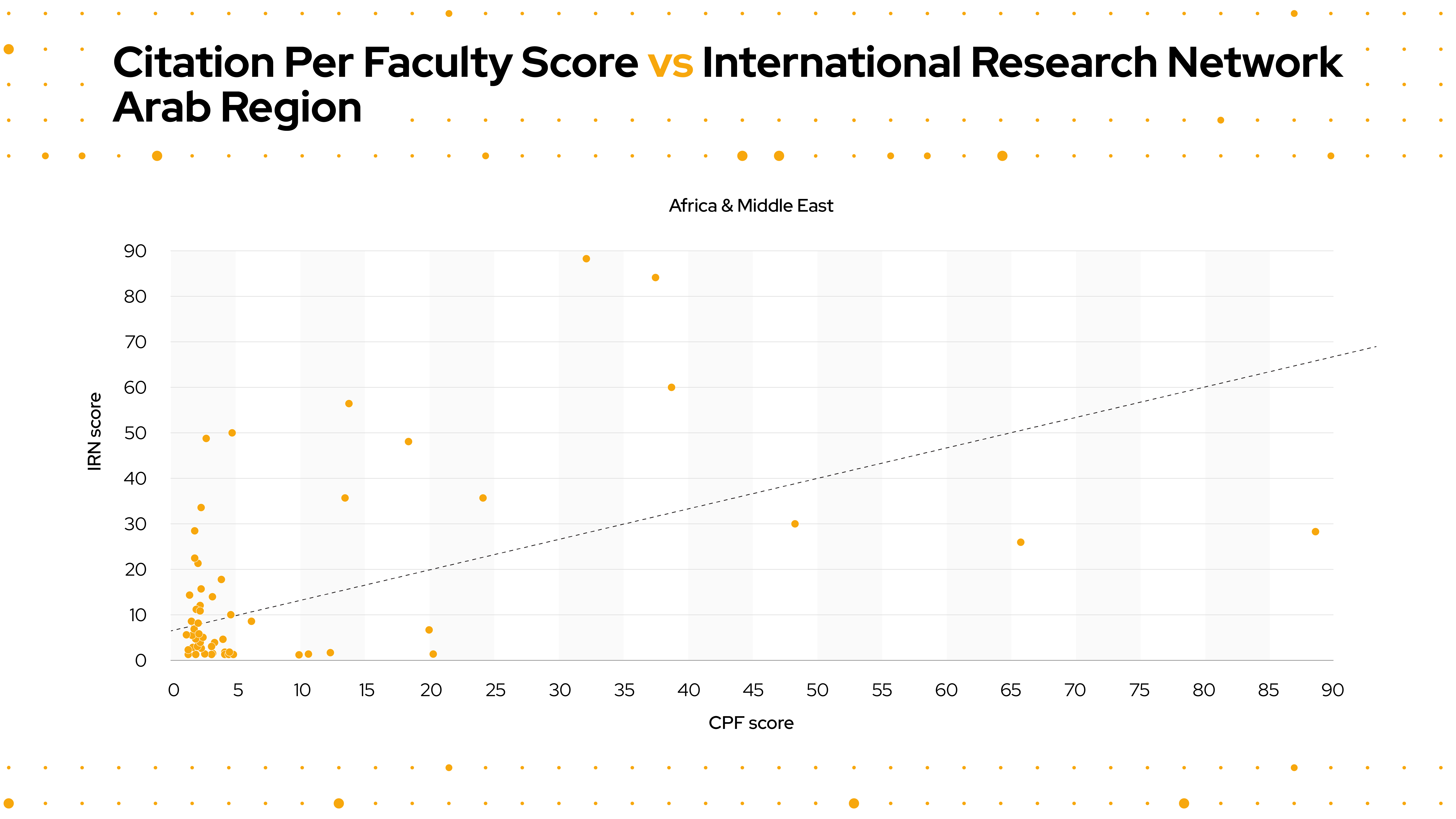
Data from the QS Global Academic Survey 2024 shows that, among academics, Engineering and Technology is the most highly regarded subject in the Middle East. Computer Science and Information Systems, and Electrical and Electronic Engineering are the top two most nominated sub-fields.
But when we consider the broader impact of research, citations and international collaborations must be considered.
Will Arab universities strengthen their academic standing in the upcoming QS World University Rankings: Arab Region 2025?
Find out on October 18 when we launch our newest ranking.

In the chart above, we see Arab universities’ Citation per Faculty score, measured against their International Research Network Score. The cluster in the left tells us that many universities in the Arab region currently have low Citations per Faculty scores, indicating limited research impact and recognition. Additionally, there is significant potential to improve their global research presence, as reflected by their International Research Network scores. There are clear opportunities for universities in the Arab region to expand their reach and influence beyond national borders.
Academic research collaboration has numerous benefits for education institutions, including knowledge exchange, enhanced research quality, and an increase in publications through industry-shared insights, ensuring that institutions remain relevant with the employment landscape.
Speaking at the QS Higher Ed Summit: Middle East 2024, Dr Tod A. Laursen, Chancellor at the American University of Sharjah, corroborated the data, saying that collaboration at the regional and local levels in the UAE is minimal, and the need for change is urgent.
How can universities in the region make research more relevant and compelling?
We explored this topic in detail at the QS Higher Ed Summit: Middle East 2024 earlier this year. Higher education experts discussed how to create a strong local research environment within the sector during a panel discussion, titled, ‘Quality Research for the Real World’.
In the panel, Professor Michael J. Benedik, Provost at Hamad Bin Khalifa University, looked at what needs to be improved to become a high-quality research institution. He broke his thinking into ‘levels’:
- Build the culture – “You have to start with building a university that has a research culture. Good or bad, research needs to be acknowledged as important and something that students can benefit from.”
- Quality and impact – “In order to enable the research to be more recognised, we can do that by how we reward and assess our faculty. People respond to what we expect of them. So, if the faculty understand that we need lots of publications, there’s no quality marker in there and you’re going to get lots of publications. But instead, if you tell them ‘We’re only going to consider publications in top-tier journals’, then that’s what you’re going to start getting.”
- Measuring the “how” – “Demonstrate that what you’re doing has an impact somehow, which you have to find out yourself because it varies in different areas disciplines and faculty. For some it may be changing their discipline. For others, it may be training students to go out and do start-up companies. You must take their research and start doing something with it that will change society and culture, and students must understand that their work must be affecting something.”
- Have an incentive – “This is where you start getting to more focused areas. We have a lot of talk about what universities need to start doing research that’s addressing global problems, which is true. But I don’t think that’s something one leads from the top. What you need to do is build a culture that encourages that and let’s that develop, then you can incentivise the kind of behaviours we want. For example, multidisciplinary groups addressing issues of sustainability or artificial intelligence (AI).”
- Be adaptable – “What we’re addressing now as global problems and solutions to them, are done from a very short-sighted perspective. We are all investing in AI – five years ago we weren’t. If you’re focusing on what’s trending right now, you may be really accomplished right now, but you’re going to miss the next episode that comes along.”
Pull out quote: You’re not going to be able to collaborate with someone unless you’ve visited their lab or their home institution.
How can research collaboration between universities and industry be enhanced in the region?
Later, Professor Benedik shared his perspective on how universities can better extend their collaboration efforts: by enabling faculty to engage more effectively with global universities and by understanding their institution’s unique selling points.
“You’re not going to be able to collaborate with someone unless you’ve visited their lab or their home institution. Those opportunities are how a lot of collaborations are built made are strengthened. In a previous life of mine, I was a Chief International Officer of a top 50 major research university in the US, and I would get requests for collaborations at least three to four times a week, and I wouldn’t respond to most of them because if I ask the question ‘Why would my university want to interact with yours?’ I couldn’t find an answer. Now that I am in the Middle East trying to build those collaborations, the question now is ‘What are we offering those partners to make them want to collaborate with us?’.”